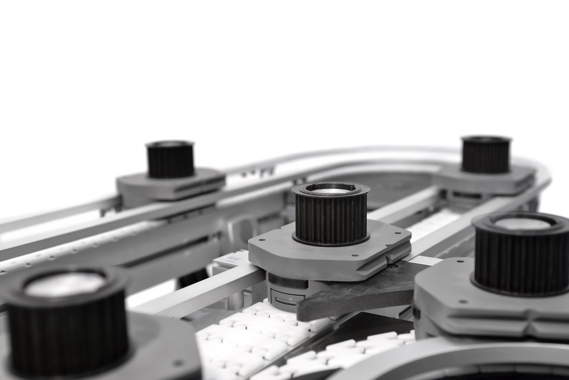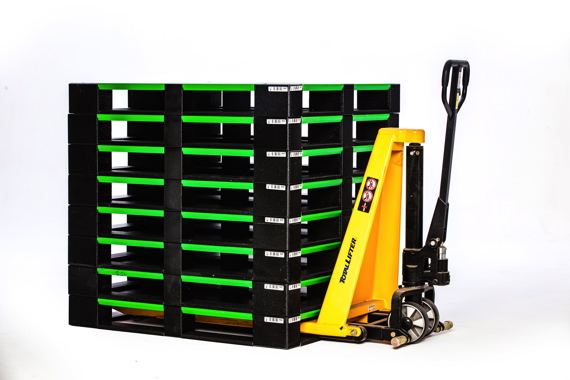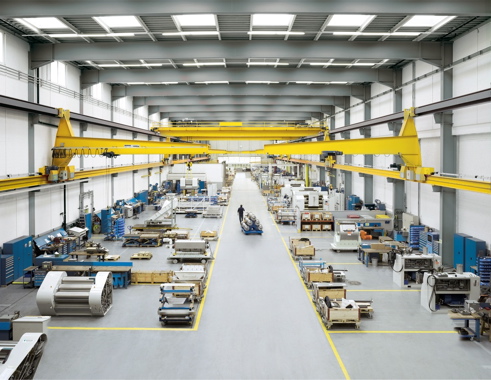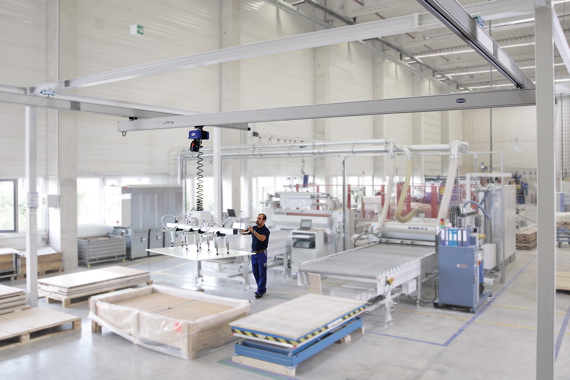
interpack 2017: Technical Article No. 5
By Melanie Streich, free-lance journalist
General BASF BMW Group DS Smith Elastocoat C spray system Euro-pallet GMA pallet industrial product packaging interpack 2017 J. Schmalz GmbH Made-to-measure packaging MDF pallets Mondi Group Pal-box PU Systems stac-pac UN Recommendations on the Transport of Dangerous Goods VacuMasterMade-to-measure packages for industrial goods—a White Paper supplied by interpack 2017.
Image caption: Wherever goods are moved quickly and in rapid succession – for incoming or outgoing goods stations, parcel distribution centers or airports – vacuum tube lifters take the strain off employees and ensure efficient materials flow. Photo: Schmalz
From S to XXL: Made-to-measure packages for industrial goods
Whether transported by sea, rail, air or road, industrial goods have to be packaged well and securely so that they reach the user or consumer in immaculate condition. The goods often travel long distances to their final destination, over bumpy roads, on clattering rails or in rough seas.
The packaged product has to withstand sharp braking and bumpy landings as well as climatic stressing and frequent reloading and repacking. In addition, packaging companies have to satisfy the rising expectations and specific needs of their customers: quality and first-class service are decisive in an industry marked by growing competition.
Called for are packaging systems that ensure minimal waste and rapid re-equipping while of course running efficiently in terms of costs, energy and resources.

Pallet conveyors convey very different products, ranging from anything from hard disk drives to ball bearings. Photo: FlexLink
Impact-resistant packages
Optimal protection on grueling journeys is provided by high-grade industrial packages made of any of a wide range of materials. Geared to the needs of the product and mode of transport, suitable protection is afforded by pallets and crates made of wood or corrugated board, collapsible transport containers and pallet cages (gitterboxes) made of plastic, transport racks, bubble-wrap packaging, bags and special heavy-duty and dangerous goods packages.
Ideal for the transport protection of fragile or impact- and scratch-sensitive products such as those made of glass, plastics or rubber are impact-resistant packages of corrugated board. Above and beyond protection, the material offers wide-ranging scope for individual design by printing and finishing. Consumption instructions and brand messages can be communicated easily without additional products, thus cutting the cost of marketing.
Pulling out the stops for genuine heavyweights
Special efforts are required for heavyweight items, i.e. goods with above-standard size or weight for transportation. For products weighing in at 100 tonnes or more, customized packaging is required. For the direct protection of the packaged contents, packagers make use of classical polyethylene or aluminum laminated films. Desiccants and chemical treatments with steam or contact phase inhibitors (using the VCI volatile corrosion inhibitor method) additionally inhibit corrosion, mold and other damage, e.g. due to condensation.
The overall packaging process for heavy goods is extremely challenging, as the loads can only be efficiently packed and loaded with the aid of heavy equipment like slewing cranes and other crane equipment. The vacuum specialist Schmalz has at its disposal special overhead cranes made of aluminum that score particularly highly with their favorable ratio of dead weight to payload.
Ergonomic and safe handling during the packaging process is assured not only by pneumatic grab systems, but also by special vacuum lifting devices. These are noted for their high degree of versatility in action, although “vacuum handling is also noted for its speed,” says J. Schmalz GmbH managing partner Dr. Kurt Schmalz.
Originally a razor blade manufacturer, the Black Forest, Germany firm has evolved since its founding in 1910 into one of the world’s leading suppliers of vacuum technology in the automation, handling and clamping sectors. Its VacuMaster swiveling lifting device is capable of effortlessly lifting metal sheets, wooden or plastic panels, drums, windows and glass panes weighing tonnes. Even heavy glass units can be loaded or packaged effortlessly and breakage-free by a single person.
Heavy equipment can be accompanied by an elaborate logistical exercise: as familiar from numerous TV reports, the transportation of heavy goods, often at night and under escort, sometimes necessitates the closure of whole roads.
Transport safety issues have to be settled in advance by everyone concerned, i.e. customer, manufacturer and haulier. Professional packaging planning is therefore indispensable when extra-large items are sent on their journey in wooden or iron crates.

Pallets are made more robust by special coatings. Photo: BASF
Safe packaging of hazardous items
A different and at the same time special kind of packaging comes into play for the shipment of dangerous goods, i.e. substances, mixtures, and objects containing substances that present specific hazards during transport owing to their nature or physical or chemical properties. Fireworks, automotive seatbelt tensioners, hair spray, petrol and fertilizers as well as airbags and lithium batteries are all classified as dangerous goods.
The packages for such substances are subject to stringent legal regulations, based on the UN Recommendations on the Transport of Dangerous Goods. Worldwide, each dangerous goods package therefore has to be marked with a UN symbol followed by an alphanumeric code.
In view of the growing popularity of electric vehicles, lithium-ion batteries are produced in large numbers worldwide. A suitable package for such dangerous goods has been designed by packaging specialist DS Smith for the BMW Group.
Thanks to the special corrugated board interior, a total of 12 power storage units can be simply and quickly lowered with lifting gear into the transport boxes and secured – without folding or further padding. Unloading is just as convenient. The batteries and padding are simply removed from the transport and storage package and, if desired, sent on individually or, for example, as a replacement parts shipment.
Pallets galore
For the handling of industrial goods, shipment pallets are perfectly adapted to needs as regards load-bearing capacity, quality and economy. But pallets can differ enormously. These practical helpers that are capable of carrying up to 1,500 kilograms are available in numerous versions on the market. Two- or four-way pallets, disposable, reusable, heavy-duty or special-purpose pallets are just some of the possible types.
One distinguishing feature is the material. The majority are made of wood, and usually of the types of wood available in the country of manufacture. Alternatively, plastic and metal pallets are employed – or pallets made of corrugated board. For the familiar Euro-pallet, birch, pine and spruce timbers are most frequently used. Depending on the stressing from the product itself, climate and handling, reusable pallets are capable of withstanding as many as fifteen trips.

oin precisely nine wooden blocks and 11 planks using 78 special nails, and you’ve got a plain but hard-wearing Euro pallet. Assembly shop at the Uzwil location. Photo: Bühler Group.
Figure 4:
Pallets are made more robust by special coatings. Photo: BASF
The American equivalent of the Euro-pallet is the GMA pallet. Measuring 40″ x 48ʺ (101.6cm x 121.92cm), it is slightly larger. For freight transport by ship, special industrial pallets are therefore required. These conform to the American system of measurement and can be loaded trouble-free into ISO containers.
Pal-box is the name of the practical pallet container made of corrugated board. The shipping container from the paper and packaging specialists of the London-based Mondi Group literally stands on its own feet. On the corrugated board box available in different sizes, the pallet feet are attached to the base. stac-pac, Mondi’s heavy-duty storage container made of die-cut heavy-duty corrugated board, is designed to handle the heaviest goods. Reinforcing wooden planks are fixed with reusable clips to the exterior for extra-high stability.
For a longer life
To improve the robustness and durability of shipping carriers made of mixed materials, special coatings can be used. The further-developed Elastocoat C spray system that seals hybrid pallets of plastic and medium-density fiberboard (MDF) for extra strength and makes additional priming superfluous comes from German chemicals giant BASF. The hybrid MDF pallets sealed with Elastocoat C are said to be not only more robust, but also some 25 per cent lighter than traditional pallets.
PU Systems team leader of sales for Western Europe Gorm Carsting explains: “The Elastocoat C spray system seals pallet surfaces efficiently, quickly and durably and thus offers optimum protection from water, dirt, microbial infestation and abrasion. The service life of pallets from Ahrma has thus been extended to up to 10 years.”

Out-of-the-ordinary packages call for special handling – in some cases with large crane systems. Photo: Schmalz
Five per cent of goods value for the packaging
In such an innovation-driven sector as packaging, technology makes all the difference. Today, packages can be produced with fewer defects, shorter production times, closer conformity to specification and more energy-efficiently than ever before. Customer expectations are rising accordingly. Tailoring packaging systems to individual needs is therefore decisive for success in the marketplace.
At interpack 2017 from May 4-10, 2017 in Düsseldorf, Germany, visitors can gain their own impression of suppliers’ strategies and products for satisfying market requirements.
One thing is certain: economizing in the wrong area can prove costly in the long run. If the packaged goods are damaged due to insufficient transport packaging, the loss can easily run into the thousands or tens of thousands of euros. And there’s also the risk of a tarnished image.
According to logistics experts, some five per cent of the value of the goods should therefore be spent on the packaging, and even more for high-value products or technical parts. Furthermore, extensive training and clear handling instructions for employees involved in storage and transport operations are essential.
Anyone who invests sufficiently in the packaging and draws up a precise requirements profile will save costs on possible complaints and ensure that the product and the manufacturer’s reputation remain undamaged.
It makes economic sense.
Figure 1:
Wherever goods are moved quickly and in rapid succession – for incoming or outgoing goods stations, parcel distribution centers or airports – vacuum tube lifters take the strain off employees and ensure efficient materials flow. Photo: Schmalz
Figure 2:
Pallet conveyors convey very different products, ranging from anything from hard disk drives to ball bearings. Photo: FlexLink
Figure 3:
Join precisely nine wooden blocks and 11 planks using 78 special nails, and you’ve got a plain but hard-wearing Euro pallet. Assembly shop at the Uzwil location. Photo: Bühler Group.
Figure 4:
Pallets are made more robust by special coatings. Photo: BASF
Figure 5:
Out-of-the-ordinary packages call for special handling – in some cases with large crane systems. Photo: Schmalz
Advertisement

